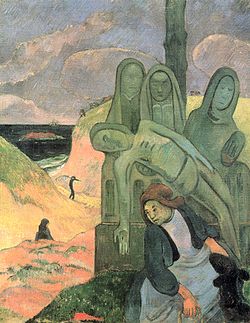The Green Christ (in French: Le Christ vert) is an oil on canvas painting executed by Paul Gauguin in the Autumn of 1889 in Pont-Aven, Brittany. Together with The Yellow Christ, it is considered to be one of the key-works of Symbolism in painting. It depicts a Breton woman at the foot of a calvary, or sculpture of Christ's crucifixion. Calvaries are common in town squares in Brittany. The woman appears to be hiding from a pair of figures in the distant background; the green Christ providing her cover from these people.
| The Green Christ | |
|---|---|
 | |
| Artist | Paul Gauguin |
| Year | 1889 |
| Medium | Oil on canvas |
| Dimensions | 92 cm × 73 cm (36.2 in × 28.7 in) |
| Location | Royal Museums of Fine Arts of Belgium, Brussels |
Topographically, the site depicted is the Atlantic coast at Le Pouldu. But the calvary depicted is an amalgam of several calvaries from different places; the cross is based upon that in the centre of Névez, a community close to Pont-Aven, located several miles from the coast, and the figure of Christ is based upon the calvarie at Briec, also at some distance from the sea.[1][2][3]
See also
editReferences
edit- ^ Dario Gamboni, Paul Gauguin: The Mysterious Centre of Thought, Reaktion Books, 2014, pp. 135, 157, 280, 281
- ^ Jean-François Staszak, Géographies de Gauguin, Editions Bréal, 2003 (French), ISBN 2749520754, 9782749520759, pp. 47-48
- ^ Catherine Puget, Peintres de la Bretagne et quête spirituelle, Musée de Pont Aven, 2006 (French), pp. 9, 25, 48